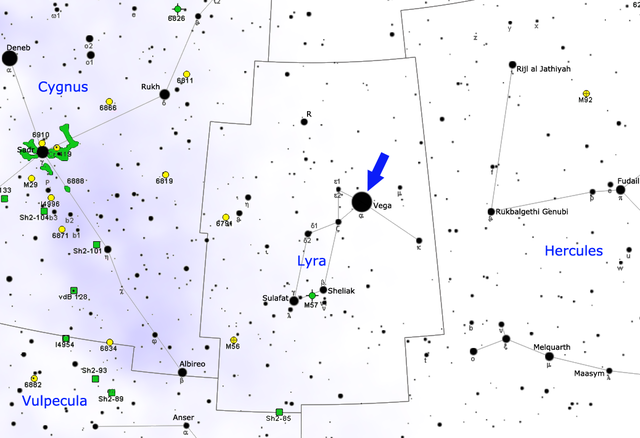Vega, Alpha Lyrae, is the brightest star in Lyra constellation and the fifth brightest star in the sky. It is only fainter than Sirius in Canis Major, Canopus in Carina, Alpha Centauri in Centaurus, and Arcturus in Boötes constellation. It is the second brightest star in the northern celestial hemisphere, with only Arcturus appearing brighter.
Vega can be seen from latitudes north of 51°S, but not from the southernmost parts of South America. For those living north of latitude 51°N, the star is circumpolar (it never sets below the horizon).
Vega is one of the three stars that form a prominent summer asterism, the Summer Triangle, along with the bright stars Altair in Aquila constellation and Deneb in Cygnus.
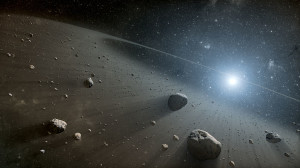
This artist’s concept illustrates an asteroid belt around the bright star Vega. Evidence for this warm ring of debris was found using NASA’s Spitzer Space Telescope, and the European Space Agency’s Herschel Space Observatory, in which NASA plays an important role. Image: NASA/JPL-Caltech
The star’s original name, Wega, was derived from a loose transliteration of wāqi‘, which means “falling” or “swooping” in Arabic and refers to “the falling or swooping eagle” or an-nasr al-wāqi‘.
Lyra constellation was depicted as a falling eagle or vulture in ancient times in Egypt and India.
Curiously, this gives Vega a “bird” connection with the other two stars of the Summer Triangle, located in Aquila (the Eagle) and Cygnus (the Swan) constellations.
Facts
Vega belongs to the spectral class A0 V, which means that it is a bluish white main sequence star that is still fusing hydrogen to helium in its core. The star will eventually evolve into a red giant and later become a white dwarf.
Vega has an apparent magnitude of 0.03 and is approximately 25 light years distant from Earth and the solar sytem. It is 40 times more luminous than the Sun, and one of the most luminous stars in the vicinity of our solar system, along with Sirius and Arcturus, which are also nearby (8.6 and 37 light years distant respectively).
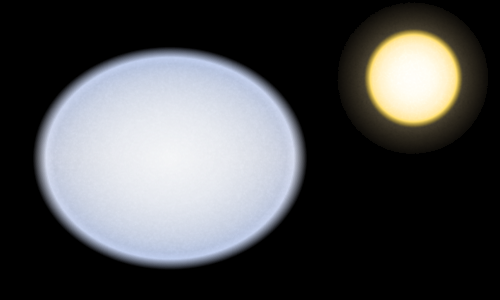
This illustration compares the rapidly rotating Vega (left) to the smaller Sun (right). Image: RJHall at wikipedia.org
Vega’s estimated age is 455 million years, which is about a tenth of the Sun’s age. It is, however, 2.1 times as massive and its lifespan will also be about a tenth of the Sun’s, roughly a billion years. To a hypothetical observer in the Vega system, the Sun would appear as a dim star with a magnitude of 4.3, located in the direction of Columba constellation.
Not counting the Sun, Vega was the first star to be photographed and have its spectrum recorded. It was photographed on July 17, 1850 by John Adams Whiple and William Bond at the Harvard College Observatory. The star’s spectrum was first photographed in August 1872 by Henry Draper.
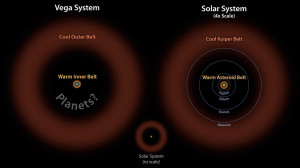
Astronomers have discovered what appears to be a large asteroid belt around the bright star Vega, as illustrated here at left in brown. The ring of warm, rocky debris was detected using NASA’s Spitzer Space Telescope, and the European Space Agency’s Herschel Space Observatory, in which NASA plays an important role. In this diagram, the Vega system, which was already known to have a cooler outer belt of comets (orange), is compared to our solar system with its asteroid and Kuiper belts. The relative size of our solar system compared to Vega is illustrated by the small drawing in the middle. On the right, our solar system is scaled up four times. The comparison illustrates that both systems have inner and outer belts with similar proportions. The gap between the inner and outer debris belts in both systems works out to a ratio of about 1-to-10, with the outer belt 10 times farther away from its host star than the inner belt. Astronomers think that the gap in the Vega system may be filled with planets, as is the case in our solar system. Image: NASA/JPL-Caltech
Among other firsts, Vega was the first solitary main-sequence star other than the Sun known to emit X-rays, and the first star known to have a disk of dust in its orbit.
Vega shows occasional low-amplitude pulsations and variations in luminosity, and it is a suspected Delta Scuti variable. These stars, also known as dwarf Cepheids, show variations in luminosity as a result of both radial and non-radial pulsations of their surface.
Vega is also a very fast spinner, rotating at a speed of up to 236.2 km/s at the equator, or 87.6 percent of the velocity that would cause it to start breaking up. As a result of centrifugal forces, the star’s equatorial region is bulging outward and the temperature of its photosphere is higher at the poles than at the equator.
The star’s radius around the equator is 19 percent larger than its polar radius. The poles are also significantly brighter than the equatorial region. As we see Vega almost exactly pole-on, the star’s visual magnitude is higher when observed from Earth. If we saw it along the plane of the equator, the star’s luminosity would be roughly half the apparent luminosity as seen from the pole.
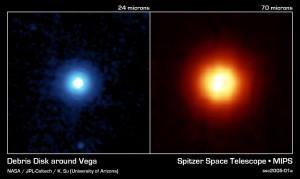
NASA’s Spitzer Space Telescope recently captured these images of the star Vega, located 25 light years away in the constellation Lyra. Spitzer was able to detect the heat radiation from the cloud of dust around the star and found that the debris disk is much larger than previously thought. This side-by-side comparison, taken by Spitzer’s multiband imaging photometer, shows the warm infrared glows from dust particles orbiting the star at wavelengths of 24 microns (on the left in blue) and 70 microns (on the right in red). Both images show a very large, circular and smooth debris disk. The disk radius extends to at least 815 astronomical units. (One astronomical unit is the distance from Earth to the Sun, which is 150-million kilometers or 93-million miles). Scientists compared the surface brightness of the disk in the infrared wavelengths to determine the temperature distribution of the disk and then refer the corresponding particle size in the disk. Most of the particles in the disk are only a few microns in size, or 100 times smaller than a grain of Earth sand. These fine dust particles originate from collisions of embryonic planets near the star at a radius of approximately 90 astronomical units, and are then blown away by Vega’s intense radiation. The mass and short lifetime of these small particles indicate that the disk detected by Spitzer is the aftermath of a large and relatively recent collision, involving bodies perhaps as big as the planet Pluto. Image: NASA/JPL-Caltech/K. Su (University of Arizona)
Our solar system is moving in Vega’s direction, at a speed of 12 miles per second, and Vega will become the brightest star in the sky in about 210,000 years, and its apparent magnitude will reach a peak at -0.81 in roughly 290,000 years. Once it reaches that point, it will be the brightest star seen from Earth for approximately 270,000 years.
Vega has a circumstellar disk of dust in its orbit, and irregularities observed in the disk indicate that there is at least one planet orbiting the star, with a size comparable to that of Jupiter.
Vega was the nearest star to the North Celestial Pole around 12,000 BCE and will take over as the northern pole star again around the year 13,727.
The star is associated with the Lyrid meteor shower, which peaks around April 21-22 every year. The shower is also known as the Alpha Lyrids because the meteor trails appear to originate in the direction of Vega. The meteor shower, however, is not physically associated with the star or Lyra constellation. It really originates from debris left by the comet C/1861 G1 Thatcher.
Vega – Alpha Lyrae
Constellation: Lyra
Location: 18h 36m 56.33635s (right ascension), +38°47’01.2802” (declination)
Spectral class: A0 V
Visual magnitude: 0.03
Absolute magnitude: 0.58
Mass: 2.135 ± 0.074 solar masses
Radius: 2.362 × 2.818 solar
Luminosity: 40.12 ± 0.45
Temperature: 8,152–10,060 K
Distance: 25.04 ± 0.07 light years (7.68 ± 0.02 parsecs)
Variable type: Delta Scuti (suspected)
Designations: Vega, Wega, α Lyrae, 3 Lyrae, GJ 721, HR 7001, BD +38°3238, HD 172167, GCTP 4293.00, LTT 15486, SAO 67174, HIP 91262
